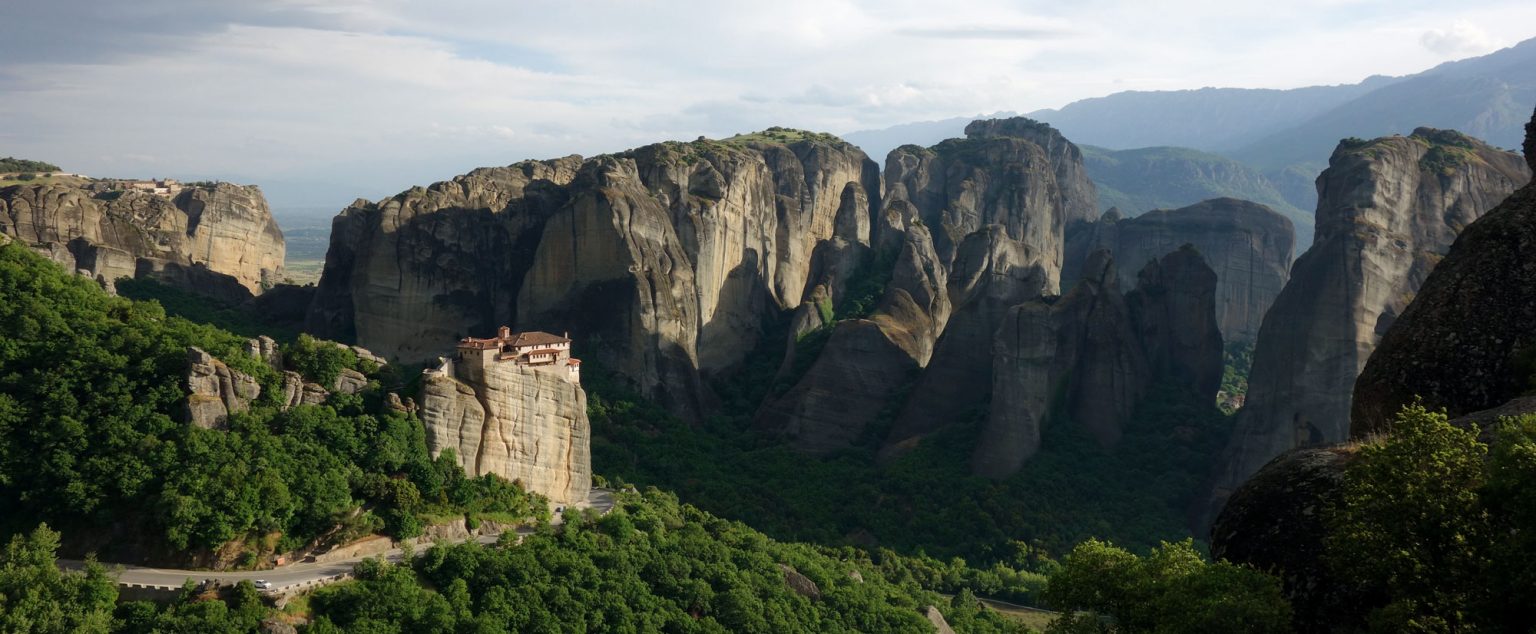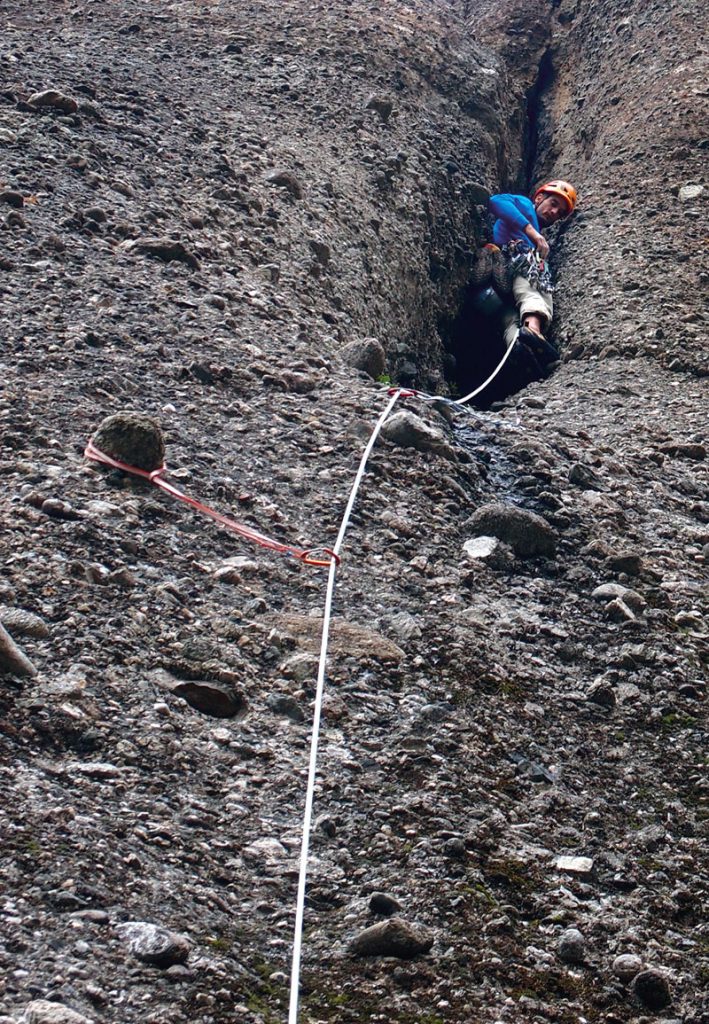Rock climbing guide to Meteora (Greece)

Climbing in the Meteora
Just like Wadi Rum, the Meteora is one of the unique places in the world that every multi-pitch climber must visit at least once in their lifetime.
Straight out of a fairytale, the conglomerate Meteora Pillars rise up from the Plain of Thessaly. Did the Orthodox Monks see in them a sign from God? Either way, they were the first to reach the summits and to start building their monasteries there as early as the 14th century!
Modern rock climbing came along much later on, beginning in 1976 when German climbers Dietrich Hasse and Heinz Lothar Stutte became fascinated by this massif. Over a period of 20 years they explored this playground, much larger than it had at first appeared to be, climbing new routes on each and every pillar except for the six pillars harbouring monasteries (following an agreement made with the monks). As time went on local climbers also became involved in climbing new – sometimes audacious – routes. Today, there are more than 700 routes spread over 175 pillars in the massif, mostly of moderate difficulty although sometimes requiring commitment disproportionate to the grade. What a priceless reward to finally top out of a route and enjoy the surreal scenery whilst writing your name in the summit register that you will find on the top of every tower! Here more than anywhere else, the pleasure of the climb far outweighs the grade of the route, and a constant desire to climb a new pillar very quickly becomes overwhelming!

The rock
The Meteora conglomerate is made up of stones of all sizes embedded in sandstone. The rock in the massif appears quite fragile on first impression, and the first routes climbed leave you with the unpleasant sensation of having been climbing “on eggs”! In fact, this impression may actually have been reality 10 years ago but it is no longer the case today, and on most of the routes the rock is sound: unstable stones on the classics have long since been purged by frequent repeat ascents, and routes that follow lines where water runs have been purged naturally. Beware, however, of the increased fragility of the rock after rain.
The commitment factor
The commitment factor of the climbing routes is the other distinctive characteristic here. Effectively, new routes were originally set bottom-up and the early climbers, of Germanic culture, favoured a minimalistic approach to bolting, very often leaving a runout of more than 10 metres between bolts (especially in sections of easy climbing). However, this highly elitist approach has evolved in recent years and numerous routes are now much more approachable, including both recently-established routes and retro-bolted lines. Commitment is still necessary and intense concentration is required from the leader, but bolt placements on the routes are well thought out: hard moves are protected whereas the highly committing sections are always at much lower climbing grades. A third distinctive characteristic is that belay anchors are still sometimes a bare minimum of one single, large ring (the upside is that backing off a climb is easy if the commitment is getting to you!).
All of these characteristics contribute to making the Meteora a perfect destination for climbing parties where there is a significant difference in ability between the team members. For the leader, the commitment compensates for the moderate grades which will be well-suited to the second.
A selection of multi-pitch routes
Contrary to popular opinion, climbing in the Meteora is very diverse, alternating between slabby sections, steep rock walls on pebbles of all sizes, and even overhangs in the gullies. The selected routes reflect this, proposing routes of varying styles, of which the vast majority are on sound rock and are relatively well protected (with the exception of a few must-do classics that feature the original runout lengths).
The digital guidebook Climbing in the Meteora
The hard copy guidebook Rock around the World
Practical information for climbing
Best seasons
Spring – from mid-April to mid-June – is ideal ; the days are longer, the weather is more stable, and the cliffs dry rapidly after rain.
The beginning of Autumn – September/October – is also pleasant and suited to climbing, but from the end of October onwards, it can be very wet.
It is possible to climb in Summer in the shade.
Approaches
The Meteora massif is very dense and it is possible to access routes on foot from Kastraki. From the road, approaches rarely exceed 15 to 20 minutes (add 10 to 20 minutes within the village if you plan on walking the whole way).
Descents
Always very quick, by abseiling. Be careful, reaching the abseil anchors from the summits often requires exposed moves (advisable to stay roped-up).
Fixed protection
Fixed protection
Initially, first ascents were made using glued-in pitons fitted with a ring. There are still some classics such as Traumpfeiler where certain pieces of original protection are still in place, although numerous routes have been re-bolted with either glue-in bolts or stainless steel expansion bolts.
Crack systems were obvious objectives for climbers and there are many traditional climbing routes in the massif, but in making our selection we have voluntarily given preference to bolted routes (except for the absolute must-do, Wahnsinnsverschneidung).
The minimalistic belay anchors made up of one single, large ring are still common but their large diameter inspires confidence.
Gear to bring
The majority of the routes described in this guidebook are bolted but in certain cases, sections of crack climbing have been kept free of fixed protection and it will be necessary to place some friends. It is also common to be able to tie-off the stones (see photo opposite) which protrude the most (thin dyneema slings recommended). A detailed description of the required gear is given for each route.
Climbing equipment necessary for a trip to the Meteora: set of half ropes 2 x 50m, 5 slings (120cm), 6 Camalots from #0.5 to #4 (Camalots #3 and #4 are only necessary for the Wahnsinnsverschneidung route).
Other useful guidebooks
Meteora, by Stutte&Hasse (Volume 1 in 1986 and Volume 2 in 2000). Both of these historical guidebooks can still be ordered on the internet. They are very comprehensive, quite easy to read (diagram-based), and do not require knowledge of German.
Greece Sport Climbing, The Best of, by Theodorapoulos (2014). Written in English, this presents a selection of crags in Greece.
General information
Updated in 2017
Languages spoken: Greek (but a large proportion of people speak or understand English)
Currency: Euros
Time zone: UTC+1hr
Electricity: 220V AC
Communication: Mobile network coverage over the entire massif and wifi is relatively easy to find
Wildlife: Snakes and scorpions (but no more than in Southern France).
Drinking water: Tap water is potable.
Emergency Services: 112 or 199. Search and Rescue can access the area quickly.
Getting there
The Meteora are located on the edge of the Plain of Thessaly, very close to the city of Kalambaka in the Peneius Valley, 230 km west of Thessaloniki and 450 km north of Athens. It is possible to travel there by air or by road from Europe (wild camping is tolerated in Greece).
Flying to Greece
Athens or Thessaloniki (closer). Direct flights take a few hours from Europe with prices ranging from €200 to €400.
Transport to the Meteora
From either airport there are buses to the area: 4 hrs from Thessaloniki (€32 return trip) or 51/2 hrs from Athens (€48 return trip). Given the low rates for car hire in Greece, particularly with pick-up from an airport, this is a good solution (from €15 per day).
On site
Where to stay
The small village of Kastraki lies in the heart of the Meteora and offers all types of accommodation at prices which vary depending on the season. In Spring and Autumn holiday rentals are available from €15 to €20 per night. For those running on a tight budget the Vrachos campsite is ideal; there is a very warm welcome, wifi at the bar, caravans which can be rented (€18 per night for two people), and a kitchen is available with a gas cooker and a refrigerator (no crockery).
Restaurants / Groceries
The Meteora is a major tourist destination with an overabundance of eating options. It is an absolute must to discover the rich flavours of Greek cuisine in the numerous local restautants, especially since the prices are so reasonable (a copious meal costs between €10 and €20).
Local gem: The Paradiso Taverna, operated by the family of Vangelis Batsios, an acclaimed local climber and first ascensionist. Great food and atmosphere!
There are bakeries and a few grocery stores in Kastraki, and the nearby town of Kalambaka has everything else one would need.
Other activities
The monasteries: It is possible to visit the 6 monasteries that are still inhabited by monks (€2 to €3 entrance fee, Metamorphosis and Vaarlam being the two most interesting).
Cragging: In 2017 Vangelis Batsios published a guidebook of sport climbing in the Meteora. And 45km away, the limestone cliff at Pily can be climbed even on rainy days (many routes graded 7b to 8a are to be found here, with the first sections of the routes remaining in the grade range 6a-6c).
Mushrooms: In Autumn, when the conditions are right, the paths are strewn with black trumpets and golden chanterelles.
